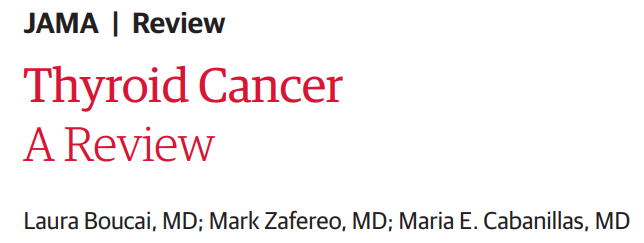博文
高达68%的人有甲状腺结节!JAMA最新综述:哪类结节需要手术?
||
高达68%的人有甲状腺结节!JAMA最新综述:哪类结节需要手术?
 医学新视点
医学新视点
·
2024/03/01
论文
论文标题:Thyroid Cancer: A Review
作者:Laura Boucai, Mark Zafereo, Maria E. Cabanillas
期刊:JAMA
发表时间:2024/02/06
数字识别码:10.1001/jama.2023.26348
摘要:Importance Approximately 43 720 new cases of thyroid carcinoma are expected to be diagnosed in 2023 in the US. Five-year relative survival is approximately 98.5%. This review summarizes current evidence regarding pathophysiology, diagnosis, and management of early-stage and advanced thyroid cancer.Observations Papillary thyroid cancer accounts for approximately 84% of all thyroid cancers. Papillary, follicular (≈4%), and oncocytic (≈2%) forms arise from thyroid follicular cells and are termed well-differentiated thyroid cancer. Aggressive forms of follicular cell-derived thyroid cancer are poorly differentiated thyroid cancer (≈5%) and anaplastic thyroid cancer (≈1%). Medullary thyroid cancer (≈4%) arises from parafollicular C cells. Most cases of well-differentiated thyroid cancer are asymptomatic and detected during physical examination or incidentally found on diagnostic imaging studies. For microcarcinomas (≤1 cm), observation without surgical resection can be considered. For tumors larger than 1 cm with or without lymph node metastases, surgery with or without radioactive iodine is curative in most cases. Surgical resection is the preferred approach for patients with recurrent locoregional disease. For metastatic disease, surgical resection or stereotactic body irradiation is favored over systemic therapy (eg, lenvatinib, dabrafenib). Antiangiogenic multikinase inhibitors (eg, sorafenib, lenvatinib, cabozantinib) are approved for thyroid cancer that does not respond to radioactive iodine, with response rates 12% to 65%. Targeted therapies such as dabrafenib and selpercatinib are directed to genetic mutations (BRAF, RET, NTRK, MEK) that give rise to thyroid cancer and are used in patients with advanced thyroid carcinoma.Conclusions Approximately 44 000 new cases of thyroid cancer are diagnosed each year in the US, with a 5-year relative survival of 98.5%. Surgery is curative in most cases of well-differentiated thyroid cancer. Radioactive iodine treatment after surgery improves overall survival in patients at high risk of recurrence. Antiangiogenic multikinase inhibitors and targeted therapies to genetic mutations that give rise to thyroid cancer are increasingly used in the treatment of metastatic disease.
查看更多
摘要翻译(由计算机程序完成,仅供参考,内容以英文原文为准):
重要性 ;约43 预计2023年美国将诊断出720例新的甲状腺癌病例。五年相对生存率约为98.5%。这篇综述总结了关于早期和晚期甲状腺癌症的病理生理学、诊断和管理的最新证据。观察结果 ;乳头状甲状腺癌症约占所有甲状腺癌的84%。乳头、毛囊(≈4%)和嗜酸细胞(≈2%)的形式起源于甲状腺毛囊细胞,称为分化良好的甲状腺癌症。侵袭性形式的毛囊细胞衍生甲状腺癌症是低分化甲状腺癌症(≈5%)和间变性甲状腺癌症(≈1%)。髓质甲状腺癌症(约4%)源于肾小球旁C细胞。大多数分化良好的甲状腺癌症病例是无症状的,在体检中发现或在诊断性影像学研究中偶然发现。对于微癌(≤1cm),可以考虑不进行手术切除的观察。对于大于1cm的肿瘤,无论是否有淋巴结转移,在大多数情况下,使用或不使用放射性碘的手术都是有效的。手术切除是复发性局部疾病患者的首选方法。对于转移性疾病,手术切除或立体定向身体照射优于全身治疗(如乐伐替尼、达巴芬尼)。抗血管生成性多激酶抑制剂(如索拉非尼、乐伐替尼、卡博扎替尼)被批准用于对放射性碘无反应的甲状腺癌症,反应率为12%至65%。靶向治疗,如达巴非尼和selpercatinib,针对引起甲状腺癌症的基因突变(BRAF、RET、NTRK、MEK),用于晚期甲状腺癌患者。结论 ;约44 美国每年新诊断出000例甲状腺癌症,5年相对生存率为98.5%。手术治疗大多数分化良好的甲状腺癌症。术后放射性碘治疗可提高高复发风险患者的总生存率。抗血管生成性多激酶抑制剂和对导致甲状腺癌症的基因突变的靶向治疗越来越多地用于治疗转移性疾病。
查看更多
所属学科:
阅读论文原文
▎药明康德内容团队编辑
甲状腺癌是内分泌系统发病率最高的恶性肿瘤之一,临床上主要将其分为乳头状癌、滤泡状癌、未分化癌以及髓样癌等。近几十年来,全球范围内甲状腺癌的发病率不断增高。2015年《柳叶刀》子刊The Lancet Diabetes & Endocrinology发表的一项基于人群的研究数据显示,在过去的30到40年里,全球甲状腺癌的发病率几乎增加了两倍。不过,尽管甲状腺癌属于常见高发癌种之一,但甲状腺癌患者的5年相对生存率却很高,达到近98.5%。
近日,《美国医学会杂志》(JAMA)发表重磅综述,总结了目前甲状腺癌发病风险因素、诊断依据和治疗的最新研究证据。
截图来源:JAMA
综述指出,甲状腺乳头状癌是甲状腺癌的最主要类型,约占所有甲状腺癌的84%。与乳头状癌、滤泡状癌等高分化甲状腺癌相比(预后相对较好),甲状腺低分化和未分化癌通常侵袭性更强。甲状腺未分化癌尽管仅占所有甲状腺癌的1%,但却占到了每年甲状腺癌相关死亡原因的19.9%,这部分患者的中位总生存期(OS)仅为6.5个月。
甲状腺癌患者一般无症状。一项回顾性研究的结果显示,只有30%的患者在确诊时伴有明显症状。此外,出现颈部肿块、吞咽困难、癔球症(指感觉咽喉部有异物样梗阻的感觉)和声音嘶哑的患者通常更有可能为晚期甲状腺癌。
甲状腺乳头状癌的最强风险因素
综述指出,儿童期电离辐射暴露与甲状腺乳头状癌发病风险相关性最强。而除此之外的绝大多数甲状腺癌风险因素是不可改变的,这些风险因素包括:年龄、性别、种族、甲状腺癌家族史。例如,年龄越大,甲状腺癌的发病率越高,患者生存率越差;女性甲状腺癌的发病率比男性高3倍。
值得一提的是,一项回顾性队列研究的结果显示,因单侧或双侧甲状腺结节、大甲状腺或自身免疫性甲状腺疾病接受甲状腺手术的患者,其术前血清促甲状腺素水平较高也与甲状腺癌的发病风险较高相关。
7%~15%的甲状腺结节为恶性
甲状腺结节可在体格检查中发现,也可在影像学检查中偶然诊断。研究数据显示,在随机选择的个体中,19%~68%可通过高分辨率甲状腺超声检测到甲状腺结节,并且女性(40.6%~44.7%)检出率比男性(27.0%~29.9%)更高。当前部分指南认为,7%~15%的甲状腺结节为恶性。
美国甲状腺协会指南(ATA)建议避免对小于1 cm的结节进行活检;甲状腺超声特征将有助于医生判断患者何时需进行细针穿刺。一项荟萃分析研究(涉及39项研究49661例患者、6种超声分类系统)的结果表明,利用超声特征(包括结节大小、回声、边界、血管分布、是否存在钙化在内)进行恶性甲状腺癌检测,敏感性为64%~77%,特异性为82%~90%;其中,ACR-TIRADS超声分类系统诊断性能最佳。
综述强调,若患者甲状腺结节≥1 cm,则只有在超声特征考虑恶性疾病时才应进行活检。通常情况下,提示恶性甲状腺癌的超声特征包括:结节边界不规则、低回声、血管增多、微钙化、横切面高大于宽(高是结节的前后距离,宽是结节的左右距离)。整体而言,甲状腺结节小于1 cm的人群、甲状腺结节小于1.5 cm且无恶性超声特征的人群,应接受超声监测而不是活检。
大多数高分化甲状腺癌可通过手术治愈
大多数高分化甲状腺癌(54%)复发风险低,单纯手术即可治愈。此外,甲状腺肿瘤较大、疑似甲状腺外侵犯、淋巴结转移或具有侵袭性组织学特征(即甲状腺髓样癌、低分化甲状腺癌、甲状腺未分化癌)的患者,可采用颈部CT或磁共振成像(MRI)进行评估。对于<4 cm的单侧高分化甲状腺癌,临床上常首选甲状腺腺叶切除术(患者生存率与甲状腺全切相当、甲状旁腺功能减退等并发症较少)。对于≥4 cm的高分化甲状腺癌和双侧甲状腺癌,一般建议行甲状腺全切术。
甲状腺全切术后给予放射性碘治疗可以摧毁术后残留的甲状腺组织和隐匿或不能手术的转移病灶。目前临床上建议高复发风险甲状腺癌患者可以进行放射性碘治疗。
小 结
目前大多数高分化甲状腺癌可以通过手术治愈。此外,术后放射性碘治疗可改善高复发风险患者的总生存率。随着越来越多抗血管生成多激酶抑制剂、甲状腺癌靶向疗法的成功,转移性甲状腺癌患者有望迎来更多的治疗策略。
免责声明:药明康德内容团队专注介绍全球生物医药健康研究进展。本文仅作信息交流之目的,文中观点不代表药明康德立场,亦不代表药明康德支持或反对文中观点。本文也不是治疗方案推荐。如需获得治疗方案指导,请前往正规医院就诊。
更多精彩内容,请关注“医学新视点”(HealthHorizon)

本文转载自“领研网”。凡本网站转载、引用的文章、图片、音频、视频文件等资料的版权归版权所有人所有,如因此产生相关后果,将由版权所有人、原始发布者和内容提供者承担,如有侵权请尽快联系删除。
文章标签
Views 14,383
Review
February 6, 2024
Thyroid CancerA ReviewLaura Boucai, MD1Mark Zafereo, MD2Maria E. Cabanillas, MD3
Audio (18:20)
0:00 / 0:00
Abstract
Importance Approximately 43 720 new cases of thyroid carcinoma are expected to be diagnosed in 2023 in the US. Five-year relative survival is approximately 98.5%. This review summarizes current evidence regarding pathophysiology, diagnosis, and management of early-stage and advanced thyroid cancer.
Observations Papillary thyroid cancer accounts for approximately 84% of all thyroid cancers. Papillary, follicular (≈4%), and oncocytic (≈2%) forms arise from thyroid follicular cells and are termed well-differentiated thyroid cancer. Aggressive forms of follicular cell-derived thyroid cancer are poorly differentiated thyroid cancer (≈5%) and anaplastic thyroid cancer (≈1%). Medullary thyroid cancer (≈4%) arises from parafollicular C cells. Most cases of well-differentiated thyroid cancer are asymptomatic and detected during physical examination or incidentally found on diagnostic imaging studies. For microcarcinomas (≤1 cm), observation without surgical resection can be considered. For tumors larger than 1 cm with or without lymph node metastases, surgery with or without radioactive iodine is curative in most cases. Surgical resection is the preferred approach for patients with recurrent locoregional disease. For metastatic disease, surgical resection or stereotactic body irradiation is favored over systemic therapy (eg, lenvatinib, dabrafenib). Antiangiogenic multikinase inhibitors (eg, sorafenib, lenvatinib, cabozantinib) are approved for thyroid cancer that does not respond to radioactive iodine, with response rates 12% to 65%. Targeted therapies such as dabrafenib and selpercatinib are directed to genetic mutations (BRAF, RET, NTRK, MEK) that give rise to thyroid cancer and are used in patients with advanced thyroid carcinoma.
Conclusions Approximately 44 000 new cases of thyroid cancer are diagnosed each year in the US, with a 5-year relative survival of 98.5%. Surgery is curative in most cases of well-differentiated thyroid cancer. Radioactive iodine treatment after surgery improves overall survival in patients at high risk of recurrence. Antiangiogenic multikinase inhibitors and targeted therapies to genetic mutations that give rise to thyroid cancer are increasingly used in the treatment of metastatic disease.
Read More AboutEndocrinology Oncology Otolaryngology Surgery Surgical Oncology Thyroid Disorders Diabetes and Endocrinology Endocrine Cancer Targeted and Immune Therapy
https://blog.sciencenet.cn/blog-280034-1424225.html
上一篇:Nature子刊:细胞中的线粒体“泄漏”了,是如何让我们生病的
下一篇:《新兴靶点:癌症治疗》报告 | 癌症治疗靶点选择趋势
全部作者的精选博文
全部作者的其他最新博文
- • 江南水乡 书画创作
- • 高手在民间 孔老师的画作
- • 名人名言 诗书画唱
- • 生物医学科研动态
- • 生物医学科研动态
- • 赵孟FU 书法 千字文




